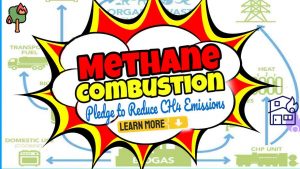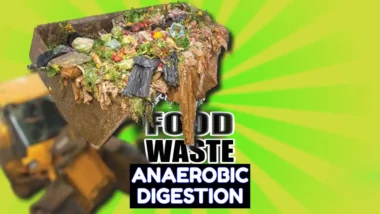Methane Stripping of Landfill Leachate refers to the removal of dissolved methane from landfill leachate before it is directly pumped into a public sewer. If the methane dissolved in leachate was allowed to enter the sewers, it may be present in sufficient concentrations to cause an explosion and/or asphyxiation risk within the sewer into which it flows.
For an explosion to happen, there would have to be a point of ignition, of course. That's important because methane in sewers rarely explodes.
Methane gas is invariably present in landfill leachate produced at landfill sites when waste naturally decomposes anaerobically and dissolves into the leachate. Methane is found at concentrations of up to about 60% in landfill gases, while the remaining 40% is largely carbon dioxide. Leachate may contain dissolved methane at up to about 15 mg/l.
 That's certainly enough to create an explosive atmosphere in the airspace of a confined space such as a manhole (sewer access chamber).
That's certainly enough to create an explosive atmosphere in the airspace of a confined space such as a manhole (sewer access chamber).
If leachate is allowed to enter the public sewer system in an uncontrolled state, when landfill gas is dissolved in it at a methane concentration above the concentration capable of vaporizing into the airspace at above the lower explosive limit, there is a serious risk.
If:
- that gas collects in the sewer in a significant volume and
- a source of ignition is also present.
This rare event may cause a serious explosion.
Methane stripping is the technique used to prevent this explosion risk by removing the methane before the leachate is discharged into a sewer.
There have been cases in which injuries have occurred from unexpected methane sewer buildup. The most common has been that access chamber covers have been blown into the air by 10 metres or more, causing a serious injury hazard. A quick search on YouTube will reveal several examples!
Read on to find out more about methane stripping plant technology:
On This Page
- Why are Methane Stripping Plants Necessary?
- In What Other Circumstances May Methane Stripping Be Needed?
- How Much Methane Is Too Much?
- Methane Stripping Plant and Equipment Supply Contractors
- Phoenix Engineering Methane Stripping Plants
- Innovative Methane Stripping Techniques
- GMCA Methane Stripping Plants
- Airless Methane Stripping
- Is the Offgas from an MSP Likely to be Explosive?
- Methane Gas and Its Removal from Water Wells
- UASB Reactors and Methane in Wastewater Treatment Works Discharges
Why are Methane Stripping Plants Necessary?
Methane is generated within the heart of a landfill, and a proportion of the gas becomes dissolved in the landfill leachate.
When leachate leaves the landfill, the methane dissolved within it will come out of solution and into any air space above it. This can be from any amount of activity or agitation, and the gas can form pockets of explosive gas within sewers and pumping stations.
In the UK, regulations are imposed to prevent sewer methane risks. Methane Stripping Plants (MSPs) are used to reduce the dissolved methane to a safe level. MSPs are designed to reduce the dissolved methane present to achieve 0.14 mg/l methane or lower.
Globally, there are many water utility companies, governments, and regulatory authorities that also require leachate discharges to contain less than 0.14 mg/l of dissolved methane at all times.
To comply with the limits placed on methane discharged to sewers, landfill owners and any other dischargers of leachate to public sewers must strip the methane out of their leachate. They do this to comply with the sewer discharge consent or agreement issued by the water company or local authority responsible for the sewer into which they discharge their leachate.
The following MythBusters experiment shows what might happen:

In What Other Circumstances May Methane Stripping Be Needed?
Methane stripping is occasionally needed in manufacturing, where processes create wastewater that contains dissolved methane.
Groundwater for drinking water production may also sometimes contain dissolved methane (CH4) at variable concentrations. Most of this important greenhouse gas is often vented to the atmosphere during primary aeration and gas stripping processes at drinking water treatment plants (DWTPs). It may or may not be prudent to apply similar stripping to such water, but this article is solely about landfill methane removal (stripping) from landfill leachate.
How Much Methane Is Too Much?
In the UK Utility Company sector and many other jurisdictions, 0.14 mg/l is the maximum permitted dissolved methane concentration allowed for any sewer discharge. Anything above that is too much!
This is a severe worst case. It makes no allowance for factors that reduce the risk.
In the US, where guidance is given on the maximum safe concentration of methane in tap water supplies, ameliorating factors that reduce explosion risk are taken into account.
In the US, there is a recommendation that action be taken to lower methane concentrations in supplies from wells for all methane concentrations above 28 mg/l in water supplies to homes.
The US advice states that:
“Methane forms an explosive mixture in air, at a concentration of 5 to 15% by volume. The exact concentration of methane in water that is capable of producing such an explosive mixture depends on:
- the water temperature,
- ventilation of the water well,
- %age composition of the gas, and
- air movement inside the house.”
The U.S. Department of the Interior, Office of Surface Mining, suggests that homeowners with wells that have methane concentrations above 28 mg/l should take immediate action to reduce this concentration.
Methane Stripping Plant and Equipment Supply Contractors
Several specialist UK contractors offer services for landfill leachate extraction, pumping, and treatment works, including the design, specification, supply, build, installation, commissioning, operation, and maintenance of leachate treatment process plants.
Phoenix Engineering Methane Stripping Plants
Phoenix Engineering has designed and built many UK MSPs, which it continues to maintain for local authorities and commercial clients.
Phoenix’s Process Director, Howard Robinson, has drafted most of the UK guidance on leachate treatment, including the present UK environment agency guidance document, “The Treatment of Landfill Leachate: Sector Guidance Note IPPC S5. 03”, under Integrated Pollution Prevention and Control (IPPC) Regulations, published in February 2007.
The design of MSPs for the removal of dissolved methane from landfill leachates is almost always based on guidelines contained within that guidance (pages 39 to 43) and has been used as a basis for the process design of all of the leachate MSPs that Phoenix Engineering has designed, constructed, and commissioned during the last 20 years.
Phoenix Engineering's methane stripping solutions enable landfill sites to meet sewage discharge consents. It is possible to achieve over 99% methane removal with relatively simple-to-operate systems. In addition, methane stripping solutions minimize the risk of explosion as a result of methane buildup from low-level release within confined spaces. All of our equipment is designed to meet specific site requirements.
Some UK leachate management specialists have pilot leachate treatment plant equipment that can be mobilized to a client's landfill site to run accurate methane-striping reactor trials.
These trial (pilot) plants are used to provide data on dissolved leachate dissolved gas concentrations and removal rates, plus mineral deposit build-up rates, for use in the design of new methane stripping plants.

Innovative Methane Stripping Techniques
Innovative MSP installation services are available to enable the stripping out of methane from the raw leachate. The use of telemetry and automated control units is also installed to ensure control of the leachate within the landfill body, effective treatment, and permit compliance with the volume and quality of the discharged leachate.
Both the gaseous and dissolved methane emissions from methane stripping wastewater treatment plants are measured by either:
- online gas-phase analysis or
- grab sampling from the liquid phase.
Examples of Methane Stripping Facilities Found Online
Bridgeton Landfill is a large, closed landfill near St. Louis, MO, close to the Missouri River, where leachate was permitted to be discharged to the public sewer without biological treatment. High levels of methane and hydrogen sulfide had been measured in the public sewer. A methane and hydrogen sulfide stripping plant was designed to remove dissolved methane and hydrogen sulfide in solution before the leachate was discharged to the sewer.
GMCA Methane Stripping Plants
Greater Manchester Combined Authority (GMCA) currently manages and maintains four closed landfill sites across Greater Manchester to ensure that they are monitored for landfill gas migration and leachate pollution, preventing threats to human health or the environment.
All the leachate generated from these sites is collected and managed in drainage collection systems. Three sites have MSPs that aerate and strip collected leachate of its methane concentration before its disposal into the public sewer under individual trade effluent agreements with the local water utility provider for that area.
Airless Methane Stripping
A company called Leachate Solutions has turned away from aerated methane stripping plants. They specialize in leachate treatment and would like to introduce into the market an airless stripping process or system, which they state to be a more up-to-date alternative process for the removal of dissolved methane from water and landfill leachate.
Is the Offgas from an MSP Likely to be Explosive?
 What is the quantity of methane gas emitted from a typical landfill methane stripping plant? What are the concentrations of methane in the off-gas from a typical methane stripping plant, and will they be explosive?
What is the quantity of methane gas emitted from a typical landfill methane stripping plant? What are the concentrations of methane in the off-gas from a typical methane stripping plant, and will they be explosive?
At standard temperature and pressure, about 25 mg/l of methane gas can dissolve in water. In a landfill environment, where the atmosphere may typically comprise 60% methane and 40% carbon dioxide by volume, this figure would resolve to a maximum dissolved methane concentration of about 15 mg/l.
Using this figure and allowing for the rate of flow of even a low-rate aeration system suggests that MSP off-gas is very unlikely to be within the explosion range when mixed with the bubble aeration airflow to become off-gas.
Methane Gas and Its Removal from Water Wells
In most waterworks in Denmark, the water at Water Treatment Plants is aerated by stair aerators, but in some plants, aeration tanks or intensive tray aerators (INKA Chambers) are used to assure sufficient stripping of methane and/or hydrogen sulfide.
UASB Reactors and Methane in Wastewater Treatment Works Discharges
UASB reactors are a common technology for wastewater treatment. However, certain disadvantages must be considered. One of the disadvantages relates to the presence of dissolved gases, such as hydrogen sulfide and methane, in the effluent, which can potentially be released into the atmosphere. This can cause malodours and contribute to the greenhouse effect. In this perspective, a recent study investigated alternative techniques to minimize these disadvantages, including:
- air stripping inside the settling compartment; and
- a dissipation chamber immediately after the reactor outlet.
Contact CH4S for advice on your methane stripping solution and a quote for methane stripping plant design and construction, here.
[First published March 2021.]





